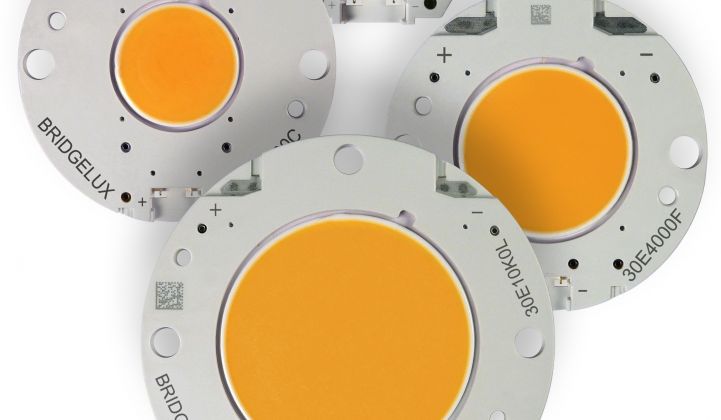An investment group led by state-owned China Electronics Corporation (CEC) and Chongqing Linkong Development Investment Company will acquire solid-state lighting startup Bridgelux.
Bridgelux will spin off its smart lighting business, Xenio, into a new standalone company. Xenio's first product is expected to ship at the end of this year. The rest of Bridgelux will become part of CEC, one of the largest IT companies in China. Bridgelux will operate as a wholly owned U.S. subsidiary of CEC.
CEC’s scope is enormous. It has more than 60 subsidiaries, 13 holding companies and 70,000 employees. It also counts many of the world’s largest electronics and technology companies as partners, including IBM, Philips, Hitachi, Sharp and Intel.
“Bridgelux has all of the characteristics we look for in an investment, including leading technology, a broad IP portfolio and a globally recognizable brand and channel,” Liu Liehong, CEO of CEC, said in a statement. “This investment is an important step toward further aligning CEC and partner assets into a coordinated supply chain built to serve the unique requirements of the solid state lighting market.”
The acquisition will allow Bridgelux to drive down costs in an increasingly competitive LED market and compete globally on stronger footing. “This was a transaction that we have designed Bridgelux to be able to enter into,” said Bridgelux CEO Brad Bullington.
Bridgelux already has strategic partnerships with other companies connected to CEC. Kaistar is a joint venture between CEC and Epistar, one of the world’s largest LED chip manufacturers. Kaistar and Bridgelux are partners for LED packaging. Additionally, Bridgelux currently uses Epistar to manufacture its LED chip designs. Both Kaistar and Epistar are investors in Bridgelux.
“Leveraging the momentum of our existing partnerships with CEC affiliates, complemented by a strong supply chain, world-class manufacturing, and chip, packaging and go-to-market capabilities, CEC will help Bridgelux expand its technology footprint and reach more customers globally,” Bullington said in a statement.
The Livermore, Calif.-based LED startup spun off its manufacturing years ago and sold its GaN-on-silicon technology to Toshiba in 2013. “This is the last step,” Bullington said of trying to be a major global LED player. “This allows us to truly focus on continuing to expand our capabilities in application-level technology and customer relationships.” He added that the acquisition would not alter Bridgelux's partnership with Toshiba. Bullington will become the executive chairman of Xenio.
Bridgelux has raised about $225 million in venture capital. Funding has come from various investors including VantagePoint Capital Partners, DCM, El Dorado Ventures, Novus Energy Partners, IFA, Chrysalix, Harris & Harris Group, Craton Equity Partners, Jebsen Asset Management, Kaistar Lighting and Passport Capital.
Although the terms of the deal were not disclosed, Bullington said the speculation by some Chinese media outlets that the deal was worth about $130 million was definitely inaccurate, but would only add that it was “materially more.” Bullington recently told Greentech Media the company had passed the mark of $100 million in revenue. The acquisition is expected to close in six to eight weeks.
This acquisition comes nearly one month after Cree announced it would restructure its LED business and consolidate manufacturing. Cree hopes to be better positioned to compete in the mid-power LED market and shift its consumer and commercial business to more high-end applications.
Bullington readily acknowledged the LED industry is in upheaval. “No one is making money,” he said, adding that more consolidation is coming “and that’s long overdue.” Not only will the acquisition help with product costs, it will also allow Bridgelux to have a more aggressive roadmap, both in terms of geographic expansion and product portfolio.
“Now we have the balance sheet to where we can envision bolting on more capability,” said Bullington, adding that there is an appetite to consolidate even more into Bridgelux. “We can go on the offensive at this point.”



